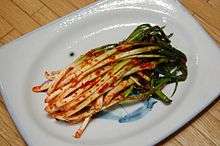Allium × wakegi
| Wakegi onion | |
|---|---|
| Scientific classification | |
| Kingdom: | Plantae |
| Clade: | Angiosperms |
| Clade: | Monocots |
| Order: | Asparagales |
| Family: | Amaryllidaceae |
| Subfamily: | Allioideae |
| Genus: | Allium |
| Species: | A. × wakegi |
| Binomial name | |
| Allium × wakegi Araki | |
Allium × wakegi, the Wakegi onion, is a species of perennial onion. It is a diploid hybrid between the bunching onion and the shallot.[1][2]
Also known as turfed stone leek, it may be cultivated commercially and for foliage.[3][4] It is described as a shallot which can be grown in tropical conditions.[5]
Culinary use
Korea

In Korea, Allium × wakegi along with Allium fistulosum is called pa(파, "scallion"), while common onions are called yangpa(양파, "Western scallion"). While Allium × wakegi is called jjokpa(쪽파), Allium fistulosum is called either daepa(대파, "big scallion") or silpa(실파, "thread scallion") depending on the size. Unlike daepa and silpa, which are usually used as a spice, herb, or garnish, jjokpa is often used as the main ingredient of various scallion dishes in Korean cuisine.
Dishes
- pajeon – a type of jeon, made by placing jjokpa parellely on a hot pan with vegetable oil, pan-frying them, then ladling onto them the batter made by mixing wheat flour, water, doenjang (soybean paste), and sugar. The jeon is turned over when the bottom holds together and is golden-brown. It is usually served with a dipping sauce made of soy sauce,
- pakimchi – a type of kimchi, made by salting jjokpa with aekjeot (liquid jeotgal), then seasoning the salted jjokpa with the mixture of chapssalpul (glutinous rice flour boiled in water), gochutgaru (chilli powder), and maesilcheong
See also
References
- ↑ Yamashita, Kenichiro; Tashiro, Yosuke (2001). "RFLP Analysis of Mitochondrial DNA in Wakegi Onion.". Engei Gakkai zasshi. 70 (2): 232–234. doi:10.2503/jjshs.70.232.
- ↑ James L. Brewster (1 January 2008). Onions and Other Vegetable Alliums. CABI. pp. 152–3. ISBN 978-1-84593-622-8.
- ↑ Haim D. Rabinowitch; Lesley Currah (2002). Allium Crop Science: Recent Advances. CABI. pp. 87–8. ISBN 978-0-85199-510-6.
- ↑ Vincent E. Rubatzky; Mas Yamaguchi (6 December 2012). World Vegetables: Principles, Production, and Nutritive Values. Springer Science & Business Media. pp. 307–8. ISBN 978-1-4615-6015-9.
- ↑ Jaime Prohens-Tomás; Fernando Nuez (6 December 2007). Vegetables II: Fabaceae, Liliaceae, Solanaceae, and Umbelliferae. Springer Science & Business Media. pp. 124, 152. ISBN 978-0-387-74110-9.
